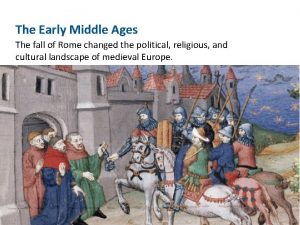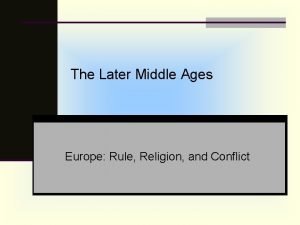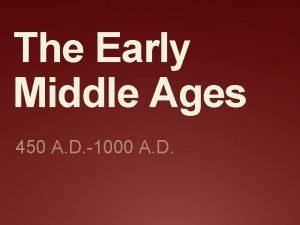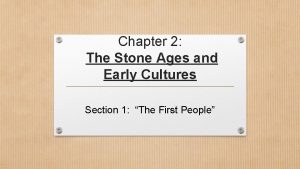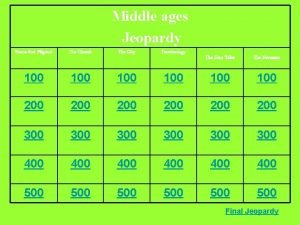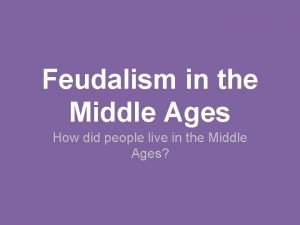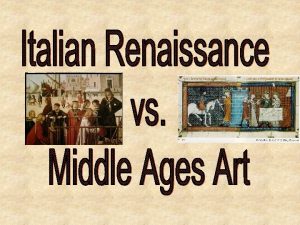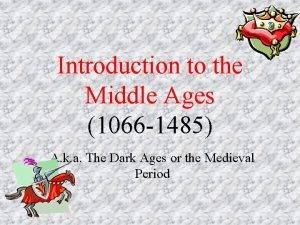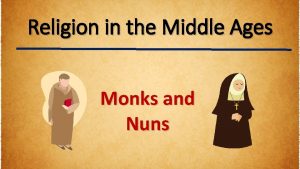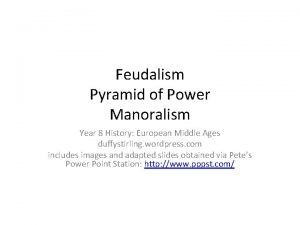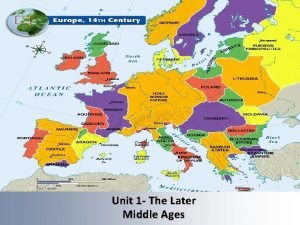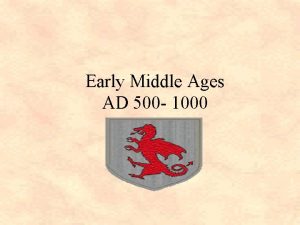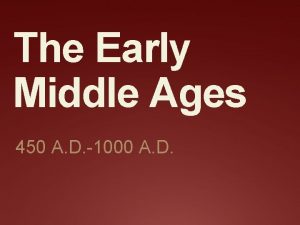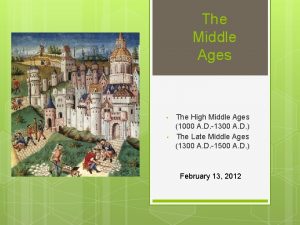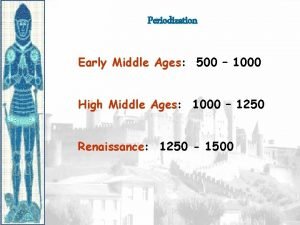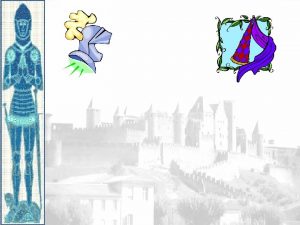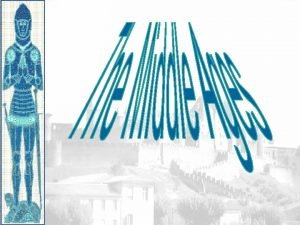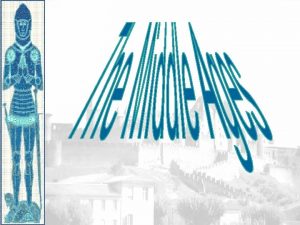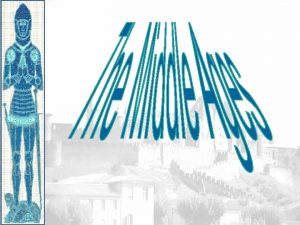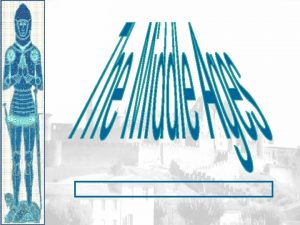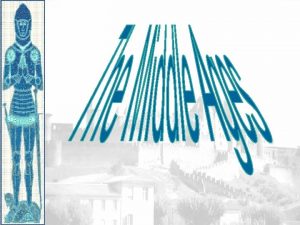The Early Middle Ages 450 A D 1000


















- Slides: 18

The Early Middle Ages 450 A. D. -1000 A. D.

The Vikings v Even before Charlemagne’s death, the earliest Viking raids struck Europe. v From about 800 to 1000 A. D. , the Vikings raided from Ireland to Russia. v The raiders were known by several names: Northmen, Norsemen, and Vikings. v Their home lay far to the north in a region called Scandinavia. This region is modern day Norway, Sweden, and Denmark.

The Vikings v The people of Scandinavia were Germanic with customs and languages similar to those of the Franks, Saxons, and Goths. v The had no contact with Rome. v They were still pagans, worshipping warlike Gods. v Raids were quick and brutal. Viking warships were a technological marvel of their age.

Viking Review 1. The Vikings raided Europe long before Pepin the Short b) Clovis c) Charlemagne d) The Vikings didn’t raid Europe a) 2. Vikings worshipped Themselves b) Christianity c) Buddha d) Pagan Gods a)

Long, lean, and light, the largest of these ships could hold 300 warriors , who took turns rowing its 72 oars. Even though the a ship might weigh 20 tons, it could sail in 3 feet of water.

Viking Invasions As explorers, the Vikings were unsurpassed. In 982, an outlaw named Eric the Red sailed west across the Atlantic waters. Around the year 1000 A. D. , his son discovered the Americas long before Columbus.

The End of the Viking Age v Around the year 1000 A. D. , the Viking terror slowly faded and cam to an end. v 3 things lead to its end: v Europeans found a way to respond quickly to raids and small-scale invasions. v The Vikings gradually adopted Christianity. v The climate changed across Europe, which allowed farming conditions to improve. v Western Europe was at last free of invasions.

Viking Review 3. The Viking Age came to an end around 1500 A. D. b) 1000 A. D. c) 800 A. D. d) 900 A. D. a) 4. Viking invasions were Swift and brutal b) A chance to learn new customs c) A religious experience d) Long lasting and intense a)

Viking Review 5. Viking ships could sail in just 10 ft of water b) 3 ft of water c) 20 ft of water d) 30 ft of water a) 6. The reason for the end of the Viking age was Europeans found a way to respond to the invasions b) The Vikings adopted Christianity c) Because of a climate change in Europe d) All of the above a)

The Rise of Feudalism v A political and military system based on the holding of land. v A powerful noble (lord) granted land called a fief to a lesser noble (vassal) who used the land & its products v The fief remained the property of the powerful noble v In return, the vassal promised loyalty, military assistance, and other services to the lord. v The vassal would divide the land to attract warriors that could fight to protect the land the lord.

The Feudal Pyramid

Problems with Feudalism v Ambitious knights could collect fiefs (land) from several lords by pledging to serve them all. v In many cases, two of the knight’s lords would go to war against each other and the knight would have to choose for which lord he would fight. v Lords could demand about 40 days of combat on horseback every year. v Since weapons, armor, and warhorses were expensive, it meant the vassal needed more land.

Peacetime Duties v Vassals were required to hold courts of justice, to charge tolls on the bridges, to collect taxes, and much more. v Justice was the lord’s largest peacetime responsibility. v Bishops that became vassals could act as the lord’s secretary, writing letters and keeping records. v The lord would travel to a vassal’s fief and expect to be housed, wined, and dined for several days.

The Manor System v The Manor was a small estate from which a lord’s family gained its livelihood. v The peasants were taxed laborers on the manor who produced everything the lord needed in exchange for using land for their own needs. v Most peasants were serfs –tenants who were bound to the land until death. v All peasants, free or serf paid dearly for the right to live and grow crops on the lord’s land.

A Medieval Manor

Manor Life v Life on a manor was harsh. Peasant men and women rarely traveled from their own manor. v Winters were miserable and made life difficult. v The duties required to the lord caused great suffering and sometimes lead to starvation. v Diseases and wars also caused great problems at the manor.

Feudalism Review 7) What is the order of the Feudalism pyramid King b) Lord c) Knight d) Peasants/Serfs a) 8) What was used to confirm the agreement between the Vassal(King) and Lord? A fief(land) b) A handshake c) A kiss d) A contract a)

Feudalism Review 9. A manor took care of itself by producing a) Food Clothing c) Weapons d) All of the above b) 10. Manor life was harsh because Starvation was always a possibility b) Winters were long and unbearable c) Lord’s demands were high d) All of the above a)
 Dark ages vs middle ages
Dark ages vs middle ages Dark ages vs middle ages
Dark ages vs middle ages Early middle ages
Early middle ages Early middle ages
Early middle ages Trigonometri
Trigonometri 450 ad
450 ad Chapter 7 early childhood ages 3 through 5
Chapter 7 early childhood ages 3 through 5 The stone ages and early cultures
The stone ages and early cultures Medieval period 1066 to 1485
Medieval period 1066 to 1485 Renaissance floral design history
Renaissance floral design history Language answer
Language answer Feudal system in the middle ages
Feudal system in the middle ages Dark ages vs renaissance
Dark ages vs renaissance Naissance renaissance
Naissance renaissance The middle ages 1066 to 1485 unit test closed book
The middle ages 1066 to 1485 unit test closed book Monks and nuns in the middle ages
Monks and nuns in the middle ages Middle ages pyramid of power
Middle ages pyramid of power Middle ages def
Middle ages def Map of europe in middle ages
Map of europe in middle ages


